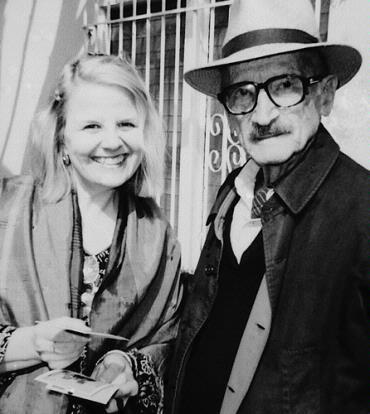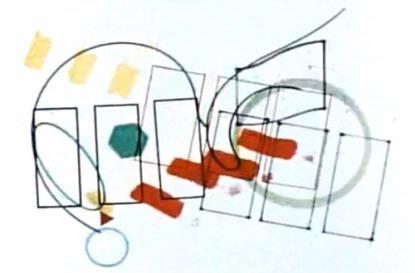
A dictionary begins when it no longer gives the meaning of words, but their tasks.
— Georges Bataille
It is most often the case when I refer to my work as experimental animation that I am met with the question, what is experimental animation? I am instantly reminded of a story about Louis Armstrong in conversation with Johnny Carson who asked Armstrong, “What is jazz?” Louis Armstrong enthusiastically responded, “Well if you don’t know what it is, I sure as hell can’t tell you!”
In some ways, Louis Armstrong’s response might be said to be universal for questions having to do with art, in that any attempt to offer definition tends to further confuse, bind, constrict and/or be irrelevant, rather than to clarify meaning. As a scholar and as an artist, I am most interested in the unanswerable. As I understand it, to ask the unanswerable is the beginning of an event … if you will, an event of language, timing and gesture, experimentation and conceptualizing. The more important consideration in a “what is ____?” question is not the answer, but the asking.. How is it we know so little about the art form?
The artist is a creative intellectual, not an inspired idiot. — Brown Report, Harvard University, 1956
With an historical critical trajectory in mind, I would like to briefly consider the advent of Modernist artists who widely experimented with new concepts of time and movement in painting, dance, music, and theater, and the resulting art history generated across those disciplines. Seeking to make visible an interior life held focus, conceptually speaking, in lieu of illustrating an exterior “reality.” As if in concert, art movements in France, Germany, Russia, and Italy gave value to a critical and literary examination of rhythmic processes and multiple perspectives of forms in art, not only as spatial relationships on a flat painting surface, but temporally.

Framing Experimental Animation inside Modernism’s pursuit of a time-based visual art, experiments in animation by the painters, Léopold Survage (France, 1914), Walter Ruttmann (Germany, 1921) and Viking Eggeling (Germany,1924) were realized, but short lived, to be eclipsed by an absence of acknowledgment or by death. Léopold Survage did not live to see his paintings on glass plates filmed (the Museum of Modern Art in New York has a series of his ink washes that were studies for animations) but spoke elegantly of his conscious commitment to experiment with animation:
“I will animate my painting, I will give it movement, I will introduce rhythm into the concrete action of my abstract painting, born of my interior life; my instrument will be the cinematographic film, this true symbol of accumulated movement. It will execute the ‘scores’ of my visions, corresponding to my state of mind in its successive phases. I am creating a new visual art in time, that of colored rhythm and of rhythmic color.” (Léopold Survage)
In 1921, Walter Ruttmann exhibited the first completed experimental animation, a hand-tinted 35mm film with a live performance of a synchronous musical score composed especially for the film, “Lichtspiel Opus I.” Ruttmann was also a musician and performed with his film in the live quartet.
I give credit to our first critical theorist in experimental animation, Viking Eggeling. His experimental animation, Diagonal Symphony, was completed in 1924 but when he became ill almost immediately after its release and died, this extensive research in visual language lay dormant until the late 20th century. (Ruttmann’s “Opus I”. and Eggeling’s “Diagonal Symphony” may be found on YouTube.com, but please be aware that contemporary composers have appropriated the visuals to accompany new soundtracks.)
Experimental Animation is an important and neglected strand of experimental fine art practice. Examined in relation to art history as a whole and cinema history in particular, “all” animation has largely been considered ‘cartoon.’ When all animation is framed within cinema studies, it is largely assumed to be a subcategory of live-action, just as experimental animation is largely assumed to be a form of frame-at-a-time experimental film. A combined examination of the histories of art, cinema, and philosophy has yet to be undertaken. An arts criticism that accommodated these disciplines would be potent, precisely because it is terrain that has been overlooked. Historically deemed untenable and alien to a canon of measure and practice of fine art, experimental animation was assumed to be mode of experimental film with its accompanying standard of measure, an ill fit.
“Visualizing Art History: Experimental Animation and Its Mentor, Jules Engel” is a documentary feature (in-progress) that links this critical research to a contemporary art practice of experimental animation. An exemplary focus for any experimental art form lies in the power of an artist-mentor-educator to transform its creative practice. Jules Engel (1909-2003), who began his mainstream career as an animator for Disney’s Fantasia, was that exemplar for over three generations of students at Cal Arts.
California Institute of the Arts was the first higher educational institution in America to create an academic track for the study of animation as an art form. In the early 1970’s, Cal Arts appointed Engel the Founding Director/Chair of the Animation Department and was named Institute Fellow prior to his death in 2003. Experimental animation in America grew up in California in the belly of the beast of Hollywood and extends its reach into New England through the generations of students that Jules Engel successfully mentored in fine art, film industry, and independent film.
In closing, here is a small offering of an example of experimental animation (“Elegy for Jules”), a brief segment featuring me talking about the meaninig of “abstract” in my art, and an excerpt from my documentary in progress about the work of Jules Engel:
ELEGY FOR JULES_A Janeann Dill Film from Janeann Dill: IIACI on Vimeo.
7-minute short form documentary on Engel, “Jules Engel: An Artist For All Seasons,” on the IIACI CHANNEL
Short piece featuring me in my studio with drawings at the IIACI CHANNEL



